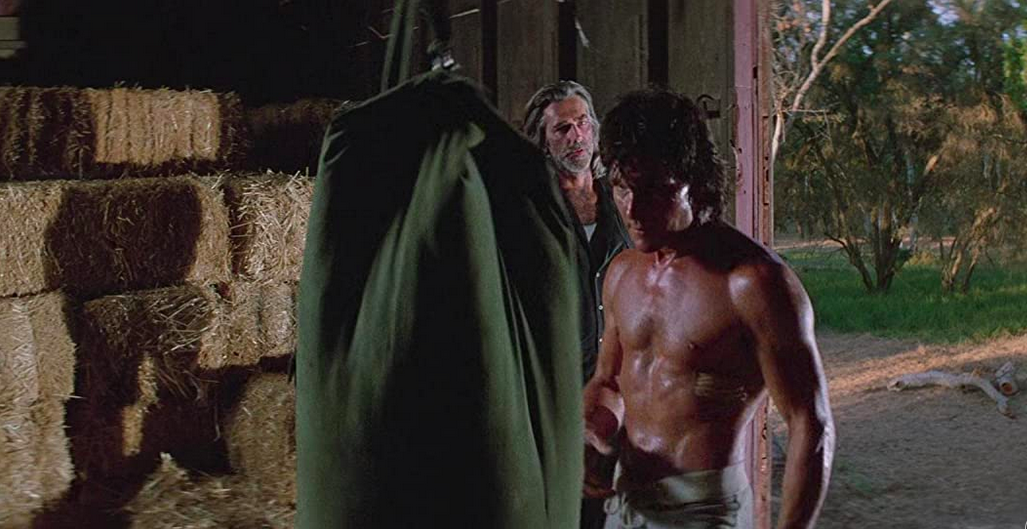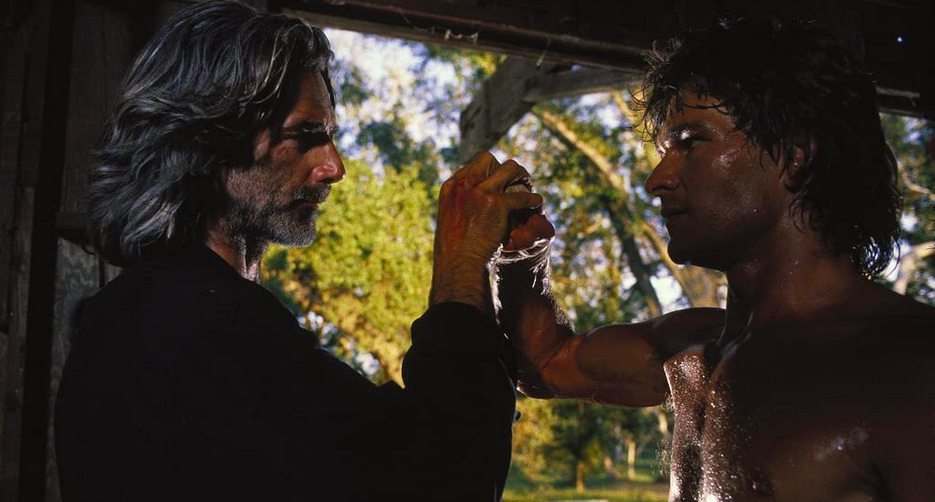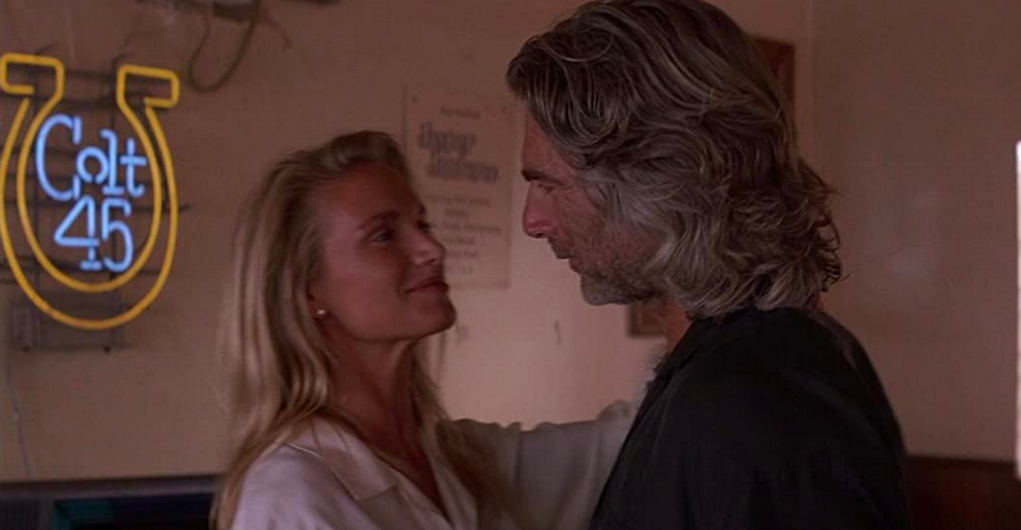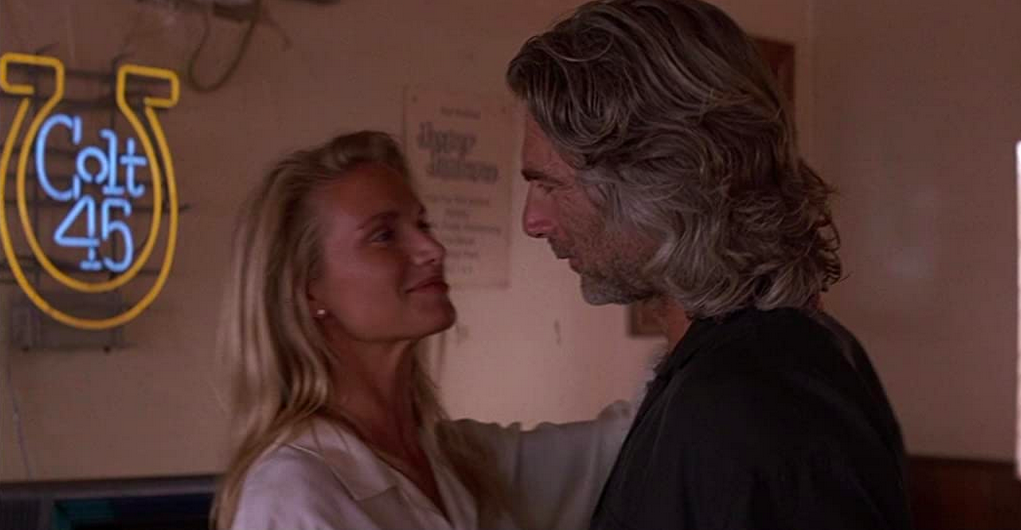Back when I tended bar in the trenches of New York City’s night scene, we had one TV tuned to some channel that replayed 1989’s “Road House,” starring Patrick Swayze, once a week, around 3:00 a.m. And, like pizza, no regulars ever got tired of it. I myself got tired of it, but … not … really. Not as much as I should have. And it occurred to me all these years later, it would be fun to explore the reasons that “Road House” simply never gets old, and has, in fact, become a cult classic.
“Road House” is the ballad of Dalton (Swayze), a fine-looking young man with a floofy mullet and high-waisted, pleated pants, who—in much the same way that the prince in “Monty Python and the Holy Grail” just wants to sing—very clearly just wants to dance. I mean … he just looks like he wants to. You know?
 One of the best bouncers in the business, Dalton (Patrick Swayze) and his phalanx of bouncers at the Double Deuce, in “Road House.” (United Artists)
One of the best bouncers in the business, Dalton (Patrick Swayze) and his phalanx of bouncers at the Double Deuce, in “Road House.” (United Artists)But he’s fated instead by The Almighty to supervise the cleaning-up of low-life drinking establishments. And thus “Road House” is the story of one bouncer’s quest to free a small town from the iron grip of the guy who is on the verge of opening the area’s first JCPenney. At least six men will die for this.
Directed by Rowdy Herrington
That’s the director’s real name—you can’t make this stuff up. Anyway, Swayze, fresh off his “Dirty Dancing” superstardom, plays a bouncer. But he’s not just any bouncer. No. Dalton’s got a philosophy degree from NYU, and Dalton knows tai chi, which he practices, sans shirt, sweatily, (for the benefit of all the ladies in the audience).
 Dalton (Patrick Swayze, foreground) lets off some steam with a make-shift heavy bag as his mentor and buddy Wade Garret (Sam Elliott) watches, in “Road House.” (United Artists)
Dalton (Patrick Swayze, foreground) lets off some steam with a make-shift heavy bag as his mentor and buddy Wade Garret (Sam Elliott) watches, in “Road House.” (United Artists)He’s also more than a mere bouncer in that he is the “cooler,” aka the head bouncer. He bounces heads off tables or bars; basically any available, firm surface, and Dalton will bounce a head off it. Which is cooler than what the regular bouncers do, who merely escort people out the door. Hence, “cooler.” You’re welcome for this explanation.
Most importantly, Dalton is a quite a famous bouncer. “Road House” takes place in an, um, alternative reality. It may look like the 1980s, but it’s really the Wild West, where outlaws named Jesse James once roamed, and where there was also a famous lawman, like Frank Dalton, Deputy U.S. Marshal for the Western District of Arkansas. So this is a “cooler” is a type of modern-day lawman, you see, which is why I believe he’s named Dalton.
And here’s the thing: Bouncers like Dalton can be so next-level awesome at their jobs that bartenders and waitstaff from thousands of miles away know their names, like rock stars, and which is why club owners will fly across the country to hire a guy who knows tai chi, philosophy, and punches overly inebriated, rowdy patrons in the face in spectacular fashion.
 The newly spiffy-ed-up road house, the Double Deuce, in “Road House.” (United Artists)
The newly spiffy-ed-up road house, the Double Deuce, in “Road House.” (United Artists)New York to Missouri
Dalton gets lured from Manhattan to Missouri (Manhattan to Missouri!) by Frank Tilghman (Kevin Tighe), the owner of a road house named the Double Deuce. Frank is getting strong-armed by one Brad Wesley, the area’s aforementioned minor organized crime boss.
Brad Wesley is portrayed by Ben Gazzara, who offers a classic lesson about show business. The acclaimed Gazzara had worked with Tennessee Williams, John Cassavetes, and the Coen Brothers. “Road House” is a far cry from “Cat on a Hot Tin Roof,” but actors are mostly in a position of “beggars can’t be choosers,” and, while one imagines Gazzara at this point in his career didn’t need the money, one can never be too sure.
Dalton finds a room in a renovated barn to rent (still’s got the hay bales) and a beat-up, brown ’65 Buick Riviera to drive, and then it’s time to clean up the Double Deuce. Unfortunately for Dalton, Brad Wesley has a vested interest in maintaining it as is, the lowliest of dive bars, since he’s in the racketeering business.
Let the Cooling Commence
Dalton immediately fires Wesley’s Double Deuce goons: a skimming bartender and a brawling bouncer played by punk-rocker John Doe and wrestler Terry Funk, respectively. Dalton espouses non-violence until such time when it no longer pays to be nice, whereupon he decisively bounces heads off (and through) tables.
 Former pro-wrestler Terry Funk as Morgan, a bad-tempered bouncer, in “Road House.” (United Artists)
Former pro-wrestler Terry Funk as Morgan, a bad-tempered bouncer, in “Road House.” (United Artists)Dalton normally likes to stitch his own wounds, like some kind of tavern security green beret, but eventually a stab wound that would kill a lesser philosophy major lands him in the local ER, and one Dr. Elizabeth Clay (Kelly Lynch) staples the slash-gash shut. When Dalton demurs on the anesthesia, because “pain don’t hurt,” she’s … intrigued.
 Dalton (Patrick Swayze) and Dr. Elizabeth Clay (Kelly Lynch) in the ER, in “Road House.” (United Artists)
Dalton (Patrick Swayze) and Dr. Elizabeth Clay (Kelly Lynch) in the ER, in “Road House.” (United Artists)However, Elizabeth and Wesley used to be an item (naturally), which makes Wesley even more determined to end Dalton. Dalton needs backup, who arrives on a Harley Dyna in the form of Dalton’s grizzled, former bouncing mentor (“the best in the business”) Wade Garrett (Sam Elliott). Note, if you will, the name consistency: the famous lawman of old, Frank Dalton, is famous bouncer Dalton in “Road House,” and Pat Garrett, the famous American Old West lawman known for killing Billy the Kid, is famous bouncer Wade Garrett, in “Road House.”
 Dalton (Patrick Swayze) goes to punch in the fact his mentor Wade Garret (Sam Elliott), who does a cool Bruce Lee-type, catch-the-fist-like-a-baseball block, in “Road House.” (United Artists)
Dalton (Patrick Swayze) goes to punch in the fact his mentor Wade Garret (Sam Elliott), who does a cool Bruce Lee-type, catch-the-fist-like-a-baseball block, in “Road House.” (United Artists)So Why Is It a Cult Classic?
The key to “Road House‘s” addictive watchability isn’t just that it’s so bad, it’s good. In its own bad way, it’s actually quite good, in terms of fun. Even though every shirt and pleated-pant on every character is a billowy fabric filched from Davy Jones’s Locker, if you can get past the late-80’s, Errol Flynn, big-hair of it all, “Road House” is a timeless classic and immensely beautiful story about how drinking overpriced alcohol and throwing empty bottles at the bandstand is worth at least six human lives.
 The bad old Double Deuce, B.D. (Before Dalton), in “Road House.” (United Artists)
The bad old Double Deuce, B.D. (Before Dalton), in “Road House.” (United Artists)The other factor is that “Road House” has the precise cheese-ball alchemy needed to spin remarkably bad sequences into hilarious gold. Yes, true, someone does get their throat ripped out. But that guy was also wearing an awesome man-choker with, like, a wolf’s claw on it. His time on earth was always going to be brief.
And some truly seasoned pros of Hollywood action are involved in this thing. It’s got the producer of “The Matrix” and “Lethal Weapon” series; the cinematographer from “Jurassic Park,” “Back to the Future,” and “Escape from New York”; and the editors from “Die Hard,” “Predator,” “Commando,” “RoboCop,” “Total Recall,” “Basic Instinct,” and “Tombstone.”
Some of these are of course projects that happened after “Road House,” but the point is, everybody who was anybody in 1980’s and ’90’s action cinema were involved in this silliness.
And, of course, the performances leave nothing on the table. That’s because there are no tables left. Nope. All shattered by bouncing heads. Lynch as the Doc has serious chemistry with Swayze, so much so that apparently Bill Murray calls Lynch’s husband on the phone to rib him every time the film’s big lurve scene comes on TV.
Gazzara is clearly having immense amounts of fun, and Sam Elliott’s Garrett is a silver fox of a black t-shirt-wearing, Harley-riding, laconic, wise-cracking, smooth-operating, modern cowboy tough-guy for the ages.
 Dalton: “What are you doing?” Wade Garrett: “Stealin’ yer woman.” Wade Garret (Sam Elliot) dances with the doctor (Kelly Lynch) in “Road House.” (United Artists)
Dalton: “What are you doing?” Wade Garrett: “Stealin’ yer woman.” Wade Garret (Sam Elliot) dances with the doctor (Kelly Lynch) in “Road House.” (United Artists)Patrick Swayze’s charisma is the mainstay. Bruce Lee was a philosophy major in real life, too, and so who can resist the reincarnation of lawman Frank Dalton bouncing heads with the martial philosophy of Bruce Lee?
Like Lee, trained-dancer Swayze has the magnetism born of physical grace and physique, plus Swayze’s got the Southern gentlemanly charm of a native Texan with actual bar-fight experience. It’s Swayze’s odd swagger that’s riveting, which is a bizarre combo of machismo and ballet; he’ll punch you right in your stupid face, but his flying kicks have a distinct air of “Swan Lake” about them.
 (L–R) Dalton (Patrick Swayze), Dr. Elizabeth Clay (Kelly Lynch), and Wade Garret (Sam Elliott) pose for a publicity shot for “Road House.” (United Artists)
(L–R) Dalton (Patrick Swayze), Dr. Elizabeth Clay (Kelly Lynch), and Wade Garret (Sam Elliott) pose for a publicity shot for “Road House.” (United Artists)But the true heart of “Road House” is that it taps into that peculiar, endlessly romanticized atmosphere of the American Wild West, with its scenes of two highly dangerous, elusive, infuriatingly independent, immensely violent yet-soft-spoken, Southern-gentlemanly alphas, trading war stories and showing battle scars over whiskey in dimly lit bars, in the presence of a beautiful woman.
Which includes Garret jokingly putting the moves on Dalton’s girl, dancing at sun-up in a greasy-spoon diner to “All My Ex’s Live in Texas.” And rumbling, in response to her question of whether this is the part where Garrett tells her what a great guy Dalton is: “Hardly. This is the part where I tell you I want you for myself” (in not an entirely harmless way).
Alpha males in all the dangerous professions and hobbies steal each other’s gear and women on a regular basis. Similarities to “Butch Cassidy and the Sundance Kid” abound. America can’t get enough of that particular bad-boy atmosphere.
And so America never tires of the bone-crunching action, neo-Western flavor, exceptionally silly but fun dialogue, and the overall vibe that crazy things can happen at a moment’s notice. “Road House” is one of those films where you’ll always find new things you never noticed before. In other words, this good bad movie functions in many ways, like a good, good movie. It’s also a reminder of a whole genre of film that has dried up; nobody makes a small action movie anymore.
And that is why, whenever “Road House” came back on at 3 o’clock in the morning, I’d go, “Ugh” … and then start chuckling a few minutes later.
 Movie poster for “Road House.” (United Artists)
Movie poster for “Road House.” (United Artists)‘Road House’
Director: Rowdy Herrington
Starring: Patrick Swayze, Sam Elliot, Kelly Lynch, Ben Gazzara, Kevin Tighe, Jeff Healey, Kathleen Wilholte, Terry Funk, John Doe
MPAA Rating: R
Running Time: 1 hour, 54 minutes
Release Date: May 19, 1989
Rating: 4 stars out of 5 for fun, 1.5 stars for ridiculousness
 RSS Feed
RSS Feed















 September 24th, 2022
September 24th, 2022  Awake Goy
Awake Goy  Posted in
Posted in  Tags:
Tags: 




































